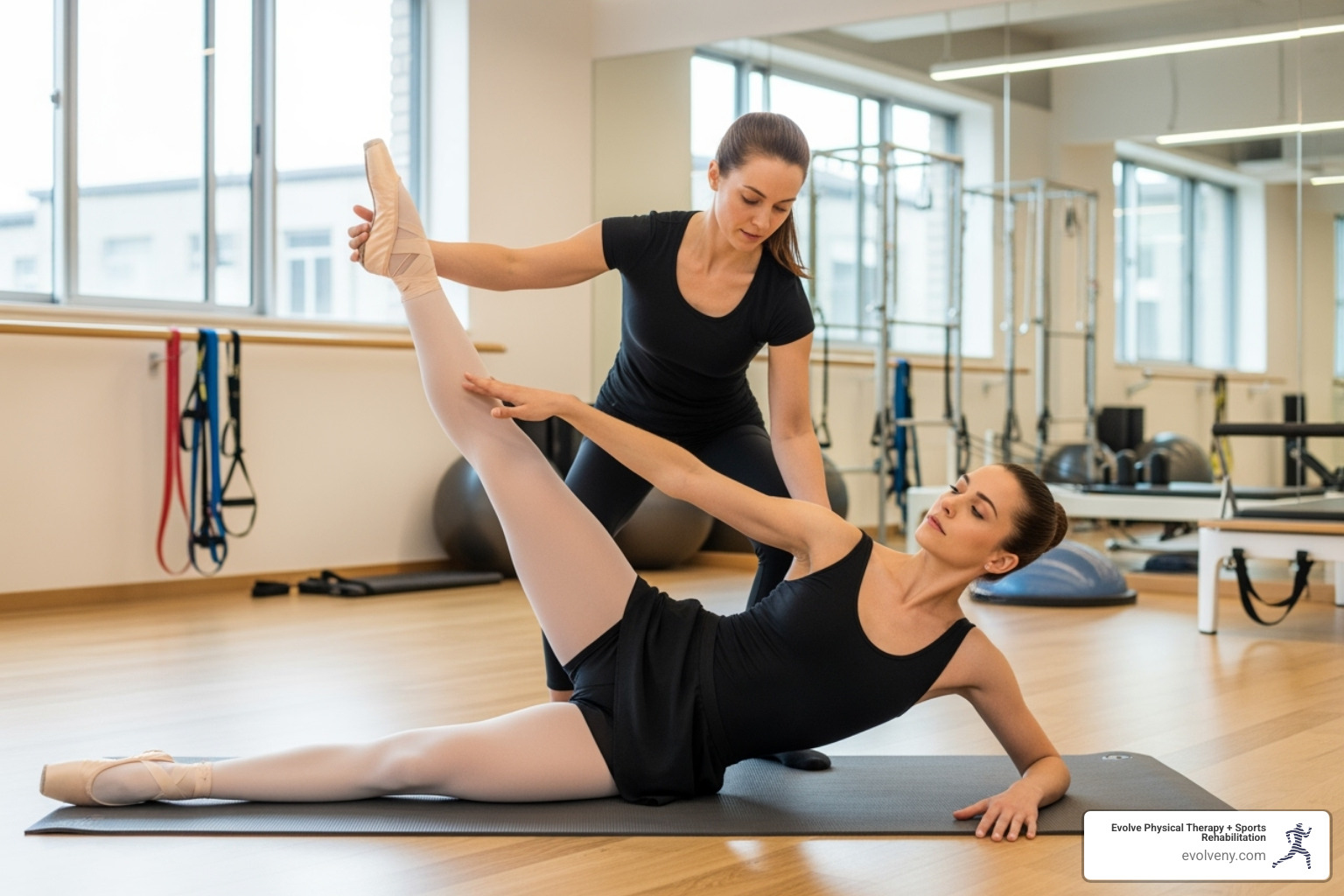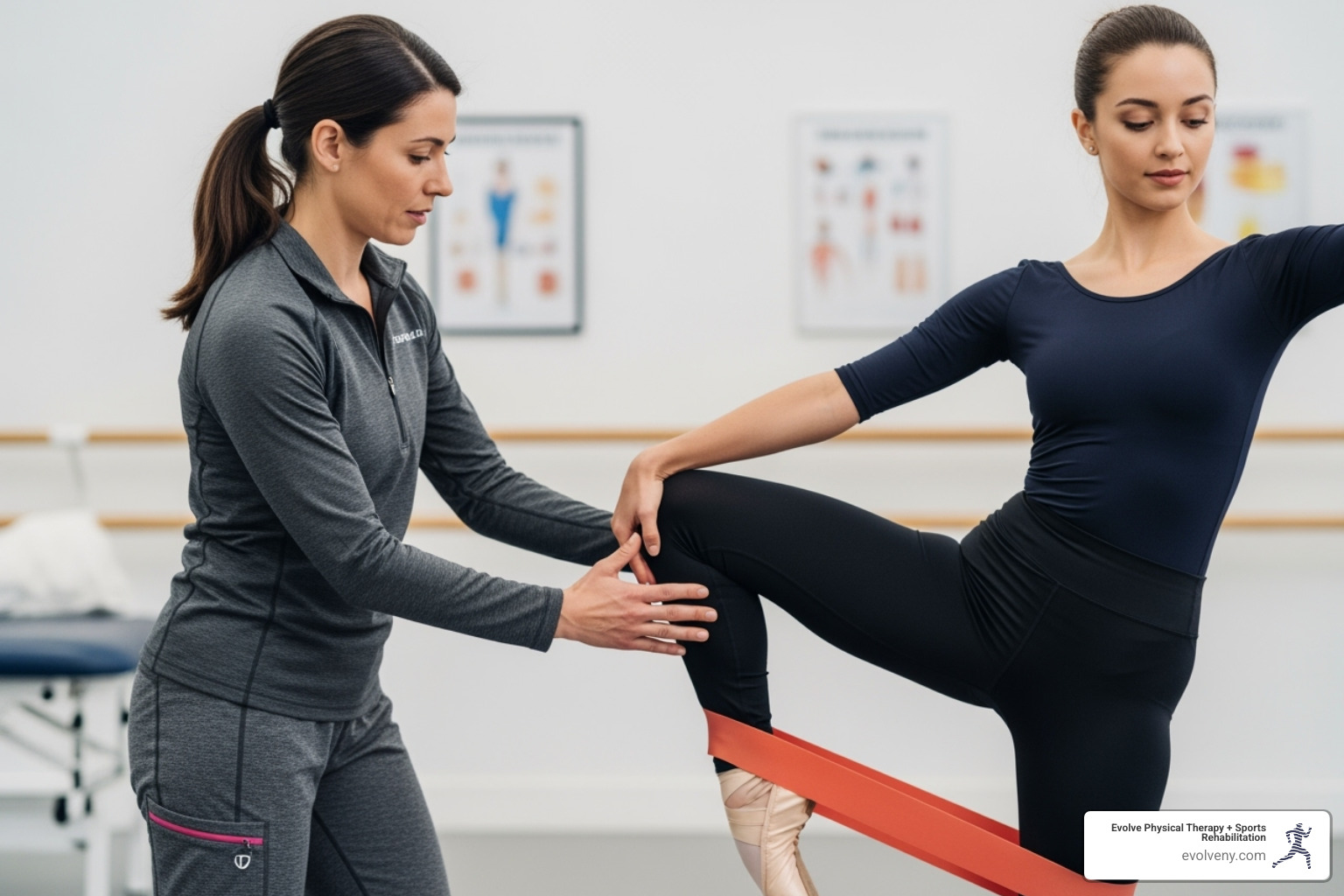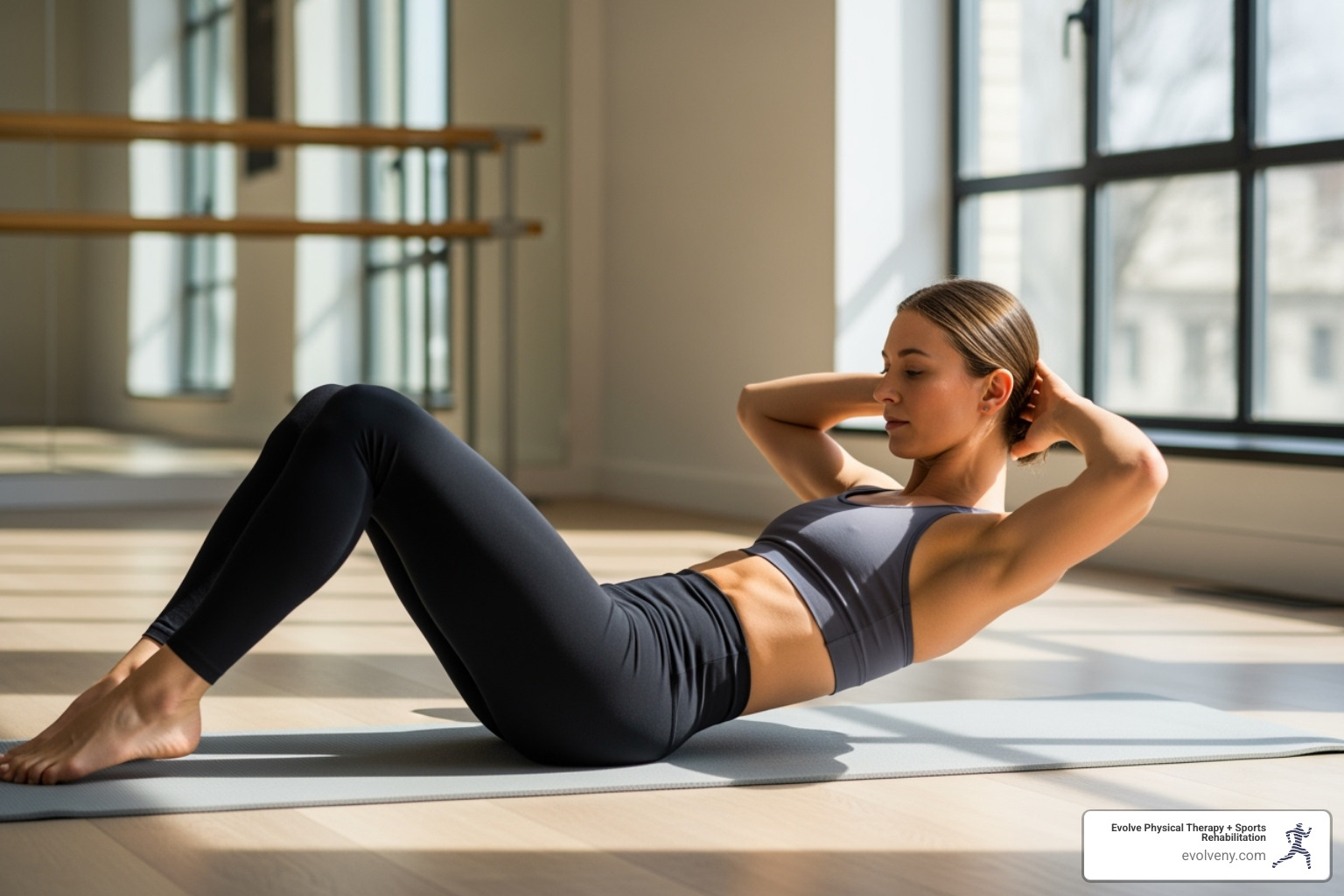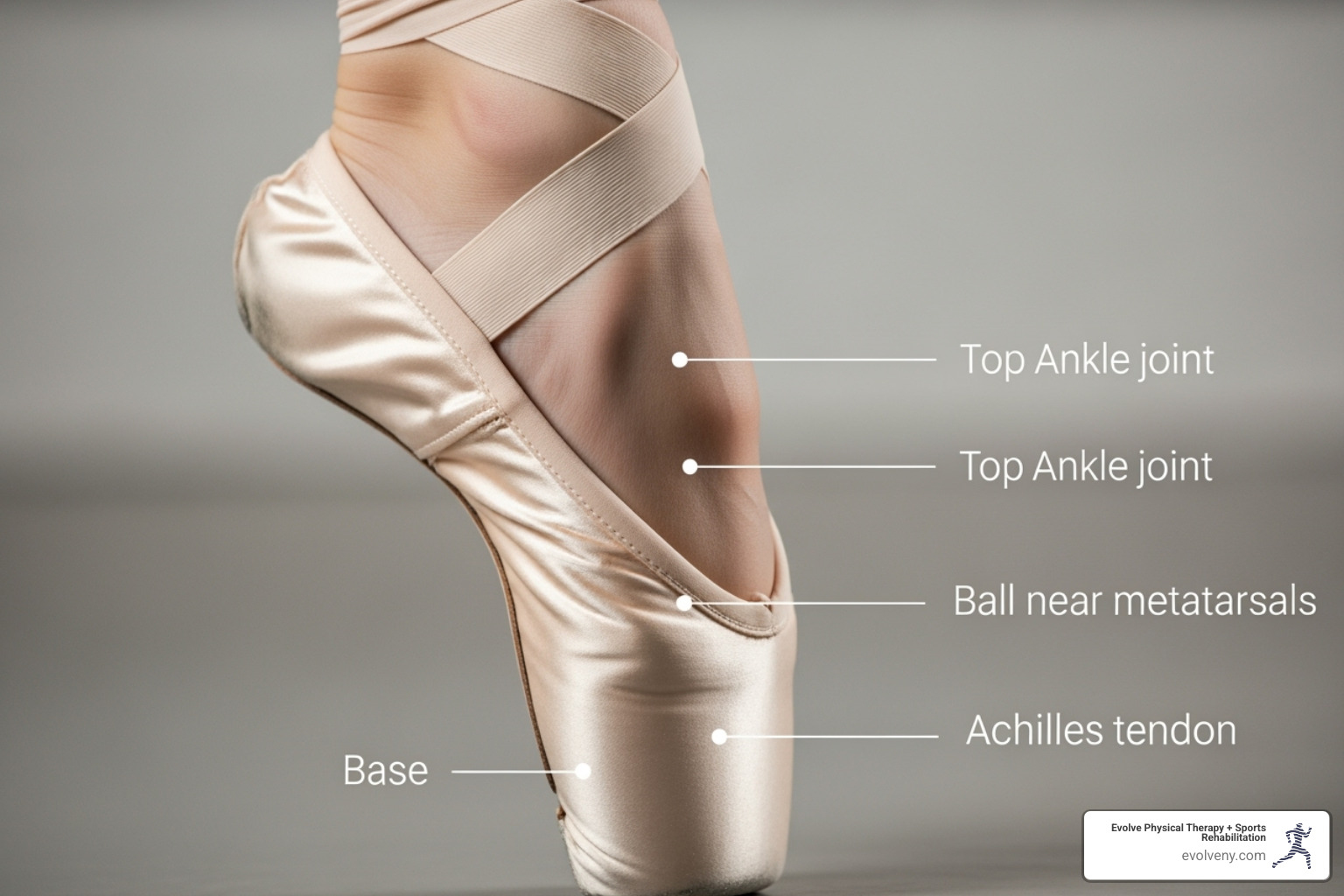On Pointe Recovery – Physical Therapy for Dance Injuries
Why Dance Demands More Than Standard Physical Therapy

Physical therapy for dancers is a specialized discipline that addresses the unique biomechanical demands of dance while supporting both injury recovery and performance improvement. Here's what makes it essential:
- Treats dance-specific injuries like patellofemoral pain syndrome, ankle sprains, stress fractures, and snapping hip syndrome
- Addresses the root causes of pain through hands-on manual therapy, alignment correction, and movement retraining
- Improves performance by improving technique, turnout, stability, and movement efficiency
- Prevents future injuries through targeted strengthening, flexibility work, and biomechanical analysis
- Speaks your language using dance terminology and understanding the artistic demands of your craft
Dance is an extraordinary blend of art and athleticism. As one physical therapist who works extensively with dancers noted, "Dancers are incredible athletes with control and grace like no other." But this beauty comes at a cost. Research shows that 67-95% of professional dancers experience injuries annually, with 87.7% of those injuries occurring from the hip down. The repetitive nature of ballet movements, high training volumes averaging 20 hours per week, and the need to push beyond normal anatomical limits make dancers particularly vulnerable to overuse injuries.
Unlike standard physical therapy, dance rehabilitation requires a deep understanding of dance technique, biomechanics, and the specific movements that define your art form. A therapist who understands the difference between a plié and a relevé, who can assess your turnout mechanics, and who recognizes that your body is your instrument can make the difference between simply healing and returning stronger than before.
I'm Lou Ezrick, founder of Evolve Physical Therapy, and over nearly two decades, I've specialized in treating complex musculoskeletal conditions and helping artistic athletes optimize their movement patterns. Physical therapy for dancers requires a holistic, hands-on approach that addresses not just the injury site but the entire kinetic chain—from how you initiate movement to how you land from a jump.
The Dancer's Body: Common Injuries and Their Causes
Your body is your instrument, and the high training volume of dance—often 20 hours or more per week—leads to overuse injuries from repetitive strain. Dancers push beyond normal anatomical limits, creating a perfect storm for injury. Research shows injury rates spike during peak rehearsal and performance seasons (typically October, November, March, and April), highlighting the need for specialized physical therapy for dancers that understands the art form's unique demands.
The Lower Body Under Pressure: Foot, Ankle, and Knee Injuries
Over 50% of all dance injuries occur in the foot and ankle, with another 16.1% affecting the knee. Your lower body absorbs tremendous force with every movement.
- Patellofemoral Pain Syndrome ("Dancer's Knee"): Pain around or behind the kneecap, often from inflammation of the cartilage. It's aggravated by turning, jumping, poor posture, or hard studio floors.
- Ankle Sprains: Common during turns and leaps, these happen when ligaments are overstretched or torn.
- Achilles Tendonitis: A burning pain in the back of the lower leg from the inflammation caused by repetitive jumping and push-offs.
- Sesamoiditis: Inflammation of the small bones under the big toe joint, creating sharp pain. It is particularly common for dancers en pointe due to constant pressure.
- Stress Fractures: Tiny cracks in the bone that develop gradually from repetitive impact without adequate recovery time. They often start as a whisper and can become a major injury if ignored. A study on ballet injury incidence emphasizes how common these injuries are.
Core and Control: Hip and Back Injuries
Your hips and back are your body's control center, accounting for 21.6% and 9.4% of dance injuries, respectively. These injuries can be limiting as they affect your core stability.
- Snapping Hip Syndrome: A palpable or audible "snap" around the hip when tendons glide over bone during movements like développés. While not always painful, it signals improper mechanics.
- Femoral Acetabular Impingement (FAI): Painful pinching in the hip joint caused by extra bone growth, which can limit your range of motion during extensions.
- Spondylolisthesis: A stress fracture in a vertebra, causing it to slip forward. This can be caused by the repeated hyperextension of the spine in movements like arabesques.
- Lower Back Pain & Sciatica: Lower back pain is often a red flag for poor core control or muscle imbalances. It can lead to sciatica, which causes shooting pain down one or both legs.
Key risk factors for all dance injuries include poor technique, muscle imbalances, inadequate rest, and nutritional deficits. Understanding these risks is the first step toward prevention and where specialized physical therapy for dancers becomes invaluable.
The Role of Specialized Physical Therapy for Dancers
Specialized physical therapy for dancers recognizes that your body is your instrument. At Evolve Physical Therapy, our holistic approach goes beyond treating an injury to improve your technique and build career-long resilience. We create custom treatment plans that address how you move, your performance goals, and what your body needs to thrive in the demanding world of dance.
The Initial Assessment: A Dance-Specific Evaluation
The foundation of effective treatment is a thorough, dance-specific evaluation. After listening to your dance history and goals, we perform a comprehensive assessment including:
- Posture and Gait Analysis: Examining your alignment both standing still and in motion to find compensatory patterns.
- Joint Range of Motion & Muscle Symmetry: Identifying areas of restriction, hypermobility, and strength imbalances between sides of the body.
- Biomechanical Analysis of Dance Movements: We watch you perform pliés, relevés, and jumps to find subtle technique flaws that may contribute to injury, such as "rolling in" at the ankles.
- Pointe-Readiness Screens: For younger ballet dancers, we conduct specialized tests of ankle strength, foot mobility, and core stability to ensure the body is ready for the demands of pointe work and to prevent serious injury.
This detailed evaluation allows us to create a treatment plan that addresses the root cause of your problem, not just the symptoms.
Custom Rehabilitation: Beyond Standard Exercises
Standard physical therapy exercises are not enough for dancers. Our custom rehabilitation programs use specialized interventions that are proven to be more effective, as supported by research on the effectiveness of physiotherapy for ballet dancers. Key components of our treatment include:
- Manual Therapy: We use hands-on techniques like joint mobilization and soft tissue massage to restore mobility, release muscle tension, and reduce pain.
- Alignment Correction & Neuromuscular Re-education: We retrain your body for optimal positioning and improve the brain-muscle connection for better coordination, balance, and proprioception (your body's awareness in space).
- Dance Modification Strategies: Instead of just telling you to rest, we work with you to modify movements—like adjusting jump height or plié depth—so you can continue training safely while you recover.
- Using Dance Terminology: We speak your language. When we talk about your turnout, développé, or épaulement, you know exactly what we mean, making our instructions immediately applicable to your training.

Communication is Key: Speaking the Language of Dance
The relationship between a dancer and physical therapist is a partnership built on clear communication. We start with collaborative goal setting to align your recovery with your artistic aspirations. We provide dancer education on anatomy and biomechanics, empowering you to understand the "why" behind your treatment. By speaking your language and demonstrating a deep knowledge of your art form, we build trust and create a space for honest conversations. Our ultimate goal is to empower you with the tools and confidence to manage your body proactively, supporting your longevity as a dancer.
From Rehabilitation to Resilience: Injury Prevention and Performance Improvement
At Evolve Physical Therapy, our approach to physical therapy for dancers extends beyond recovery to building resilience and enhancing performance. We encourage a proactive mindset, where injury prevention is woven into your training routine—like regular maintenance for your body, your most valuable instrument.
Building a Stronger Foundation: Proactive Physical therapy for dancers
Proactive physical therapy is about training smarter, not just harder. We help you build a stronger foundation for dance through:
- Cross-training: Activities like swimming, cycling, or targeted strength work build overall fitness and balance muscle development, giving your dance-specific muscles a much-needed break.
- Core Strengthening: We focus on the deep stabilizing muscles that support your pelvis and spine, providing a stable foundation for every movement you make.
- Gluteal Muscle Activation: Strong glutes are your secret weapon for knee health, powerful jumps, and safe, effective turnout. Correctly firing these muscles helps prevent conditions like patellofemoral pain syndrome.
- Proprioception and Balance Training: These exercises heighten your body's spatial awareness, leading to more precise footwork, steadier balances, and better mid-movement adjustments.
- Differentiating Flexibility vs. Hypermobility: Many dancers have extraordinary flexibility, but without adequate strength to control it, this can increase injury risk. We teach you how to identify and stabilize hypermobile joints to keep them safe.
We also emphasize daily practices like proper warm-ups, cool-downs, hydration, and listening to your body's early warning signs.

Integrating Holistic Methods for Peak Performance
We integrate specialized movement modalities to accelerate recovery and transform how you move and perform. Pilates develops precise core control and body awareness. Gyrotonic training uses three-dimensional, spiraling movements to improve spinal mobility and build strength. Yoga connects breath with movement, improving flexibility, balance, and mind-body awareness.
| Method | Primary Benefits for Dancers |
|---|---|
| Pilates | Deep core control, precise alignment, strengthening without bulk, improved stability for turns and balances |
| Gyrotonic | Improved spinal mobility and articulation, three-dimensional strength, fluid movement patterns, joint decompression |
| Yoga | Mind-body awareness, breath control, flexibility with stability, mental focus, stress reduction |
The Ultimate Goal: Enhancing Artistry and Career Longevity
Proactive physical therapy helps you dance better, longer, and with more joy. The benefits include:
- Improved Technique: With proper alignment and conditioning, movements become more efficient and lines become cleaner.
- Improved Stability: A strong foundation leads to softer landings from jumps and more confident balances.
- Greater Movement Efficiency: You conserve energy for artistry and expression, which improves your endurance.
- Increased Confidence: Trusting your strong, resilient body allows you to take artistic risks without fear.
- Reduced Re-injury Risk: By addressing the root causes of injury, we help you achieve fewer setbacks and a more sustainable career.
Why Dance Demands More Than Standard Physical Therapy
Physical therapy for dancers is a specialized discipline that addresses the unique biomechanical demands of dance while supporting both injury recovery and performance improvement. Here's what makes it essential:
- Treats dance-specific injuries such as patellofemoral pain syndrome, ankle sprains, stress fractures, and snapping hip syndrome
- Addresses root causes with manual therapy, alignment correction, and movement retraining
- Improves performance by refining technique, turnout, stability, and movement efficiency
- Prevents future injuries through targeted strengthening, flexibility work, and biomechanical analysis
- Speaks your language with dance terminology and an understanding of artistic demands
Dance blends art and athleticism, but the physical cost is high. Research shows that 67-95% of professional dancers experience injuries annually, with 87.7% occurring from the hip down. High training volumes (often ~20 hours/week), repetitive movements, and extreme ranges of motion increase overuse risk.
Unlike standard physical therapy, dance rehabilitation requires deep knowledge of technique and biomechanics. A therapist who understands a plié versus a relevé, can assess turnout mechanics, and recognizes that your body is your instrument can be the difference between simply healing and returning stronger.
I'm Lou Ezrick, founder of Evolve Physical Therapy. For nearly two decades I've helped artistic athletes resolve complex musculoskeletal issues. Effective physical therapy for dancers treats the whole kinetic chain—from initiation to landing—so you can recover and perform at your best.
The Dancer's Body: Common Injuries and Their Causes
Dancers are artistic athletes training at high volumes, often 20+ hours per week. Repetition, extreme ranges, and hard floors create overuse and biomechanical stress that demand targeted care.
The Lower Body Under Pressure: Foot, Ankle, and Knee Injuries
Over 50% of dance injuries involve the foot and ankle; another 16.1% affect the knee.
- Patellofemoral Pain Syndrome ("Dancer's Knee"): Pain around or behind the kneecap, aggravated by turning, jumping, poor posture, or hard floors.
- Ankle Sprains: Ligament overstretch/tear during turns, leaps, and quick direction changes.
- Achilles Tendonitis: Burning pain from repetitive push-offs and landings.
- Sesamoiditis: Sharp pain under the big toe joint, common en pointe due to constant pressure.
- Stress Fractures: Tiny bone cracks from repetitive impact and inadequate recovery. A study on ballet injury incidence highlights how common these are.

Core and Control: Hip and Back Injuries
Hips and back account for 21.6% and 9.4% of injuries, affecting stability and control.
- Snapping Hip Syndrome: Audible/palpable snap when tendons glide over bone during développés; signals mechanics to address.
- Femoral Acetabular Impingement (FAI): Painful pinching from extra bone growth, limiting high extensions.
- Spondylolisthesis: Vertebral stress fracture and forward slip, exacerbated by repeated hyperextension.
- Lower Back Pain & Sciatica: Often from core control deficits or imbalances; may radiate down a leg.
Key risk factors:
- Poor technique
- Muscle imbalances
- Inadequate rest
- Nutritional deficits
Understanding these patterns is step one; specialized physical therapy for dancers addresses root causes to keep you dancing.
The Role of Specialized Physical Therapy for Dancers
At Evolve Physical Therapy, we treat dancers as artists and athletes. Our holistic approach looks beyond the painful area to your technique, goals, and the specific demands of your style, building a plan that heals, improves performance, and supports longevity.
The Initial Assessment: A Dance-Specific Evaluation
- Posture and Gait Analysis: Identify static/dynamic alignment issues and compensations.
- Joint Range of Motion & Muscle Symmetry: Flag restrictions, hypermobility, and side-to-side imbalances.
- Biomechanical Analysis of Dance Movements: Observe pliés, relevés, turns, and jumps to find subtle flaws (e.g., ankle rolling in turnout).
- Pointe-Readiness Screens: Assess ankle/foot strength, mobility, balance, and core stability before going en pointe.
Custom Rehabilitation: Beyond Standard Exercises
We blend PT fundamentals with dance-specific strategies shown to help dancers. See Effectiveness of physiotherapy for ballet dancers.
- Manual Therapy: Joint mobilization and soft-tissue techniques to restore mobility and reduce pain.
- Alignment Correction & Neuromuscular Re-education: Rebuild optimal positioning, balance, and proprioception.
- Dance Modification Strategies: Adjust jump height, plié depth, or rotation so you can keep training safely.
- Using Dance Terminology: Clear cues in your language (turnout, développé, épaulement).
Communication is Key: Speaking the Language of Dance
We partner with you through:
- Collaborative goal setting aligned with training and performance schedules
- Education on body mechanics so you understand the "why" behind your plan
- Trust and empowerment that support honest dialogue and long-term self-management
From Rehabilitation to Resilience: Injury Prevention and Performance Improvement
Our goal is not just recovery but resilience. We integrate proactive care into your routine so you can perform more consistently and avoid setbacks.
Building a Stronger Foundation: Proactive Physical therapy for dancers
- Cross-training benefits: Add swimming, cycling, or strength work to balance high dance volumes without overloading the same tissues.
- Core strengthening: Train deep stabilizers for stable turns, controlled extensions, and powerful jumps.
- Gluteal activation: Protect knees, support turnout, and improve propulsion.
- Proprioception and balance training: Sharpen spatial awareness for precise footwork and steadier balances.
- Flexibility vs. hypermobility: Maintain range while stabilizing hypermobile joints.
Integrating Holistic Methods for Peak Performance
A truly holistic approach to physical therapy for dancers often incorporates specialized movement modalities that complement traditional PT. These methods not only aid in recovery but also significantly improve a dancer's technique and overall physical intelligence.
| Method | Primary Benefits for Dancers |
|---|---|
| Pilates | Focuses on core strength, stability, precision, and breath. It builds balanced musculature and improves body awareness, crucial for controlled dance movements and injury prevention. Excellent for strengthening deep stabilizers and achieving efficient movement patterns. |
| Gyrotonic Method | Emphasizes circular, flowing movements and spinal articulation. It improves spinal mobility, joint articulation, and functional strength, promoting a sense of freedom and fluidity in movement. Ideal for improving range of motion and neuromuscular coordination. |
| Yoga | Cultivates flexibility, strength, balance, and mental focus through various poses and breathwork. It improves body awareness, reduces stress, and improves overall physical and mental well-being, complementing the mental and physical demands of dance. |
The Ultimate Goal: Enhancing Artistry and Career Longevity
- Improved technique and control through alignment and conditioning
- Greater stability for softer landings and confident balances
- More efficient movement to conserve energy for artistry
- Increased confidence to take risks safely
- Lower re-injury risk by correcting root causes and building durable habits
Frequently Asked Questions about Dance Physical Therapy
What are the primary goals of physical therapy for dancers?
The primary goals extend beyond immediate pain relief. We aim to:
- Heal and Get You Back to Dancing: Address the current injury so you can return to the studio safely.
- Prevent Future Injuries: Identify and correct the root causes of the injury, such as muscle imbalances or alignment issues.
- Improve Performance: Improve your technique by strengthening specific support muscles for cleaner lines, better turnout, and more controlled movements.
- Educate and Empower: Give you the knowledge to understand your body, recognize warning signs, and manage your health for a long, successful dance career.
It's a partnership to build a more resilient and aware artist.
How does physical therapy improve a dancer's technique, not just heal an injury?
Physical therapy improves technique by identifying and correcting hidden physical limitations that may be holding you back. For example, if you struggle with your arabesque height, a therapist will analyze if tight hip flexors or inactive glutes are the true cause.
By using targeted strengthening, mobility work, and neuromuscular re-education, we correct these underlying biomechanical issues. When you learn to activate the right muscles in the right sequence, movements like balances and turns become more stable and controlled with less effort. By making your body move more efficiently, we free you to focus on your artistry.
When is it safe for a dancer to return to pointe work after an injury?
A safe return to pointe work is determined by a physical therapist through a thorough, progressive assessment, not just by the absence of pain. We evaluate multiple factors:
- Strength: We test the intrinsic foot muscles, ankles, calves, and glutes to ensure they can provide adequate support.
- Stability and Control: You must be able to perform foundational movements like single-leg relevés with perfect alignment and without pain or compensation.
- Range of Motion: You need sufficient ankle plantarflexion and foot articulation to rise onto pointe correctly.
Once these criteria are met, the return is always gradual. We start with short periods at the barre and slowly progress to more complex work, always in close communication with you and your dance instructor. This methodical approach is the best way to prevent re-injury and ensure a long-term return to dancing.
Conclusion: Take the Next Step in Your Dance Journey
Your body is your instrument, and like any finely tuned instrument, it deserves specialized care. Throughout your dance journey—from your first plié to your hundredth performance—the physical demands never let up. The beauty you create on stage comes from dedication, artistry, and yes, an extraordinary amount of physical stress.
We understand this at Evolve Physical Therapy in Brooklyn, where we serve dancers throughout Marine Park, Gravesend, Midwood, Park Slope, and Mill Basin. Physical therapy for dancers isn't something you should only think about when you're injured. It's a partnership that supports you through every stage of your career—whether you're recovering from a stress fracture, working to prevent dancer's knee, or simply looking to refine your technique and perform at your peak.
Our approach is different because we see the whole picture. We use hands-on manual therapy to address the root causes of your pain, not just mask the symptoms. We speak your language, understanding the difference between a développé and a dégagé, and we know what it takes to safely return to pointe work. We integrate holistic methods like Pilates and Gyrotonic that complement your training rather than compete with it.
Most importantly, we empower you. We teach you about your body's unique mechanics, help you build strength where you need it most, and give you the tools to stay healthy for the long haul. Because dance isn't just about getting through today's rehearsal—it's about sustaining a lifelong passion.
Whether you're dealing with an injury right now or you're ready to take a proactive approach to your physical health, we're here to help you move with greater freedom, confidence, and artistry. Your dance journey deserves a partner who truly understands what you do and what you need.
Ready to dance stronger, safer, and longer? Take control of your dance health with physical therapy.

